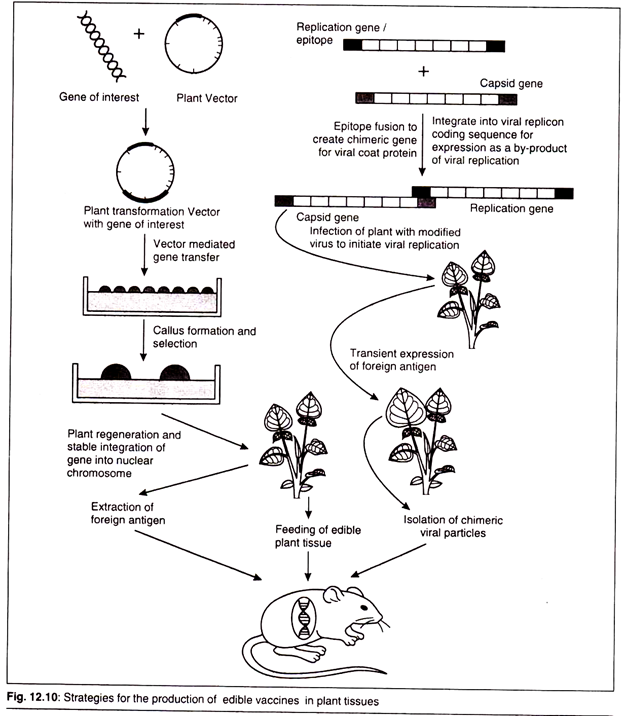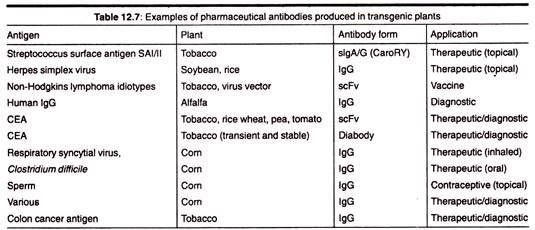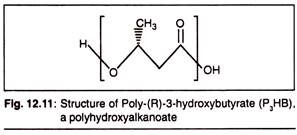The following points highlight the top four roles of transgenic plants as bioreactors. The roles are: 1. Production of Vaccine Antigens in Plants 2. Edible Vaccines 3. Antibody Production in Plants 4. Production of Biodegradable Plastics.
Transgenic Plants: Role # 1.
Production of Vaccine Antigens in Plants:
The aim of vaccination is to prevent infectious diseases. It can be considered as one of the most successful breakthrough of this century in the medical field. The principle of vaccination involves mimicking an infection in such a way that the specific natural defence mechanism of the host against the pathogen gets activated but the host remains free of the disease that normally results from such infection.
Followings are some vaccine antigens produced in plants:
(a) Escherichia Coli Labile Toxin:
E. coli labile toxin (LT) is responsible for causing diarrhoea. It is composed of a 27 kDa A subunit and five 11.6 kDa B subunits that pentamerise. The B pentamer (LT-B) has been used as a vaccine component, as antibodies against this would block toxin activity. LT-B was expressed in transgenic potato.
(b) Vibrio Cholera Toxin:
Cholera toxin (CT) is very similar to E. coli LT. The genes encoding CTA and CTB were amplified by PCR and then cloned into plant expression vectors. Expression of these genes was controlled by the CaMV strong promoter.
(c) Hepatitis B Virus Surface Antigen:
Hepatitis B virus infection causes acute or chronic hepatitis, and hepatocellular carcinoma. The first vaccine developed, consists of hepatitis B surface antigen (HBsAg). This antigen is produced in large amounts in liver cells of infected individuals. Tobacco plants were genetically transformed with the gene encoding HBsAg, which was driven by CaMV strong promoter.
Transgenic Plants: Role # 2.
Edible Vaccines:
Vaccines that one can eat along with plant products like fruits and vegetables are called as edible vaccines. Edible vaccines are currently being developed for many human and animal diseases, including measles, cholera, foot and mouth disease and hepatitis B and C.
Mechanism of Action:
Edible vaccines when taken orally undergoes mastication process. Majority of the plant cells degradation occurs in the intestine near the Peyer’s patches (PP), by the action of digestive or bacterial enzymes on edible vaccines. PP consists of 30-40 lymphoid nodules on the outer surface of the intestine and contains follicles from which germinal centre develops upon antigenic stimulation.
These follicles act as the sites from which antigen penetrates the intestinal epithelium, thereby accumulating antigen within organized lymphoid structure. The antigen then comes in contact with M- cells. M-cells express class II MHC molecules and antigens transported across the mucous membrane by M-cells can activate B-cells within these lymphoid follicles.
The activated B-cells leave the lymphoid follicles-and migrate to diffuse mucosal associated lymphoid tissue (MALT) where they differentiate into plasma cells that secrete the IgA class of antibodies.
These IgA antibodies are transported across the epithelial cells into secretions of the lumen where they can interact with antigens present in the lumen.
Transgenic Plants: Role # 3.
Antibody Production in Plants (Plantibody):
Plants are used as bioreactors for the large scale production of antibodies,called as plantibodies, for the following reasons:
1. Plants can assemble heavy and light chains into complete antibodies.
2. Plants permit appropriate post-translational modification for the production of antibodies.
3. The extraction of antibody from plant cells.
4. Genetically stable seed stocks of antibody producing plants can be produced and stored indefinitely at low cost.
Production of a fully functional antibody in plants is not a very straightforward task because of the multi-subunit structure of antibody molecule. Moreover, expression of a complete antibody may not be required for many applications.
Transgenic Plants: Role # 4.
Production of Biodegradable Plastics (Bio-Plastic):
In response to the problems associated with plastic waste and its effect on the ecosystem, there has been immense focus on the development and production of biodegradable plastics. Degradable plastics can be classified either as photodegradable or biodegradable.
Photo-degradation leads to breakdown of the polymer into smaller non-degradable fragments. On the other hand, biodegradable polymer can be degraded by non-enzymatic hydrolysis or by the action of enzyme secreted by microorganisms. Among the biodegradable plastics available, there is much interest in the group of polyhydroxyalkanoates (PHAs) polymers, produced entirely from bacterial fermentation.
However, disadvantages in microbial production via fermentation include the high cost and low production. With the recent advances in molecular biology and genetic engineering allowing the possibility of using crop plants, the PHA biosynthetic genes from a bacterium (Alcaligeneseutropus) were expressed in Arabidopsis thaliana.
Advantages of Biodegradable Plastic:
Followings are the advantages of biodegradable plastics:
1. They take less time to break down.
2. They are renewable.
3. They are good for the environment.
4. They require less energy to produce.
5. They are easier to recycle.
6. They are not toxic.
7. They reduce dependence on foreign oil.
Limitations of Biodegradable Plastics:
1. Bio-plastics are designed to be composted, not recycled. The plant-based material will actually contaminate the recycling process if not separated from conventional plastics such as soda bottles and milk jugs.
2. Home composting may not be an option. Some bio-plastics cannot be broken down by the bacteria in our backyards. Polyethylene (PE) made from cane sugar is one example of this. Only bio-plastics that are fully biodegradable will break down in a home compost pile, and it could still take up to two years for certain items (e.g., forks and spoons).
The rest require the high heat and humidity of an industrial composting facility.
3. Plants grown for bio-plastics have negative impacts of their own. Bio-plastics are often produced from genetically modified food crops such as corn, potatoes, and soybeans, a practice that carries a high risk of contaminating our food supply. Also, corn and soybean producers typically apply large amounts of chemical pesticides and fertilizers that pollute our air and water.




